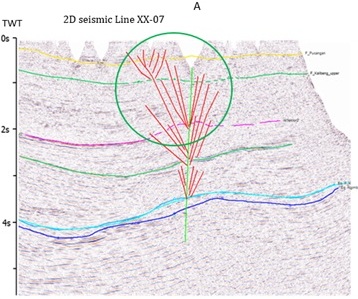Understanding Mud Volcano System Using Hele-Shaw (H-S) Experiment: Seismic Confirmation at East Java Mud Volcano
DOI:
https://doi.org/10.25299/jgeet.2021.6.4.7889Keywords:
mud volcano system, Hele-Shaw, overpressured, valve fault, critical phaseAbstract
Numerous researchers have carried out studies on the mud volcano system in East Java. However, there have been no experiments on the mud volcano system's mechanism, including overpressure confirmed by direct subsurface data. Therefore, this study aims to directly evaluate the mud volcano system's mechanism using the Hele-Shaw (H-S) experiment with the subsurface data confirmation. The H-S experiment utilized four primary materials: quartz sand diameter below 250 µm and 320 µm to analogize the porous layer. Gypsum flour clay is the ductile layer, while mud from the Kuwu and Kesongo Mud Volcanoes is the original material from nature. Wax represents impermeable material. The sealing layer is made of wax, and oxygen represents the natural fluids of the rock formation. The overpressured zone is created by pumping oxygen into a layer of quartz sand covered by a wax as an impermeable layer. Pressure is measured digitally, and the process is continuously recorded to produce traceable data. Each material was experimented on individually to determine the critical phase characteristics, valve fault structure geometry, and validation with seismic interpretation. The results indicate that the critical phase of the mud volcano system is characterized by the dome structure at the surface, with high intensify of gas and oil seepage. Piercement structure geometry is shown by plumbing of fluidization zone, which becomes shallower than before. Furthermore, each material's piercement structure geometry shows a consistent pattern, with differences in the density of the fault and pressure structures. Thus, the H-S experiment's validation with seismic interpretation shows a similar geometry in pressure structures and valve faults as the mud volcano system's migration paths.
Downloads
References
Burhannudinnur, M., 2020. The Potentials Prediction of Kradenan and Kesongo Mud Volcano Systems in East Java. Int. J. Adv. Sci. Technol. 29, 533–5 41.
Burhannudinnur, M., 2019. Mud gas play. J. Phys. Conf. Ser. 1402, 66022.
Burhannudinnur, M., 2012. Komplek Mud Volcano Kradenan, in: Proceeding PIT IAGI Yogyakarta 2012 The 41st IAGI Annual Convention and Exhibition. pp. 207–2011.
Burhannudinnur, M., Karyono., Sudradjat, A., 2021. Gunung lumpur dan fenomena lumpur Sidoarjo, Pertama. ed. CV. Galeripadi, Jakarta/Bandung.
Burhannudinnur, M., Noeradi, D., Sapiie, B., Abdassah, D., 2012. Karakater Mud Volcano di Jawa Timur, in: Proceeding PIT IAGI Yogyakarta 2012 The 41st IAGI Annual Convention and Exhibition. pp. 201–206.
Istadi, B.P., Wibowo, H.T., Sunardi, E., Hadi, S., Sawolo, N., 2012. Mud Volcano and Its Evolution, in: Imran
Ahmad Dar (Ed.), Earth Sciences. InTech, pp. 375–434.
Johnsen, Ø., Toussaint, R., Måløy, K.J., Flekkøy, E.G.F., Shmittbuhl, F., 2008. Coupled air/granular flow in a linear Hele-Shaw cell. Phys. Rev. E. Stat. Nonlin. Soft Matter Phys. 77 1 Pt 1, 011301.
Kusumastuti, A., Darmoyo, A.B., Suwarlan, W., Sosromihardjo, S.P.C., 1999. The Wunut Field: Pleistocene volcaniclastic gas sands in East Java, in: Proceedings of the 27th Annual Convention of the Indonesian PetroleumAssociation and Exhibition. Indonesian Petroleum Association, Jakarta, pp. 195–215.
Letouzey, J., Werner, P., Marty, A., 1990. Fault reactivation and structural inversion. Backarc and intraplate compressive deformations. Example of the eastern Sunda shelf (Indonesia). Tectonophysic 183, 341–362.
Mazzini, A., Nermoen, A., Krotkiewski, M., Podladchikov, Y., Planke, S., Svensen, H., 2009. Strike-slip faulting as a trigger mechanism for overpressure release through piercement structures. Implications for the Lusi mud volcano, Indonesia. Mar. Pet. Geol. 26, 1751–1765.
Nermoen, A., Galland, O., Jettestuen, E., Fristad, K., Podladchikov, Y., Svensen, H., Malthe-Sorenssen, A., 2010. Experimental and analytic modeling of piercement structures. J. Geophys. Res. Solid Earth 115, 1–15.
Rigord, P., Guarino, A., Vidal, V., Géminard, J., 2005. Localized instability of a granular layer submitted to an ascending liquid flow. Granul. Matter 7, 191–197.
Sapiie, B., Hadiana, M., 2007. Mechanism of some rift basins in Western Indonesia, in: Proceedings of 31st Annual Convention of the Indonesian PetroleumAssociation and Exhibition. Indonesian Petroleum Association, Jakarta.
Satyana, A.H., Asnidar, 2008. Mud Diapirs and Mud Volcanoes in Depressions of Java to Madura: Origins, Natures, and Implications to Petroleum System, in: Proceedings of 32nd Annual Convention of the Indonesian PetroleumAssociation and Exhibition. Indonesian Petroleum Association, Jakarta.
Sawolo, N., Sutriono, E., Istadi, B.P., Darmoyo, A.B., 2009. The LUSI mud volcano triggering controversy: Was it caused by drilling? Mar. Pet. Geol. 26, 1766–1784.
Talbot, C.J., 1995. Molding of Salt Diapirs by Stiff Overburden, in: Jackson, MPS; Roberts, DG; Snelson, S. (Ed.), Salt Tectonics: A Global Perspective: AAPG Memoir 65. The American Association of Petroleum Geologists, pp. 61–75.
Tingay, M., 2014. Initial pore pressures under the Lusi mud volcano, Indonesia. Interpretation 3, SE33–SE49.

Downloads
Published
Issue
Section
License
Copyright @2019. This is an open-access article distributed under the terms of the Creative Commons Attribution-ShareAlike 4.0 International License which permits unrestricted use, distribution, and reproduction in any medium. Copyrights of all materials published in JGEET are freely available without charge to users or / institution. Users are allowed to read, download, copy, distribute, search, or link to full-text articles in this journal without asking by giving appropriate credit, provide a link to the license, and indicate if changes were made. All of the remix, transform, or build upon the material must distribute the contributions under the same license as the original.










